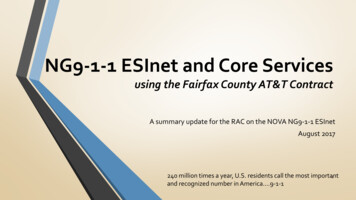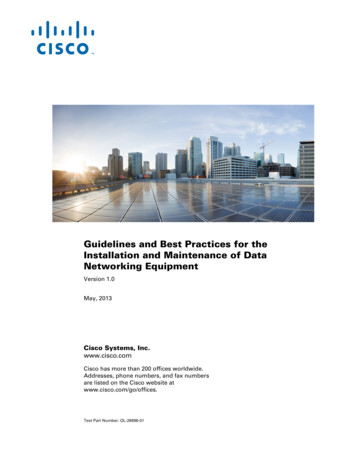
Transcription
NG9-1-1 ESInet and Core Servicesusing the Fairfax County AT&T ContractA summary update for the RAC on the NOVA NG9-1-1 ESInetAugust 2017240 million times a year, U.S. residents call the most important1and recognized number in America .9-1-1
Business Objectives Overview Obtain the capability to support PSAP/Regionaltransition to a NG9-1-1 standards-based ESInet withNext Generation Core Services (NGCS) as areplacement of the legacy Verizon 9-1-1 call routingnetwork.Provide the network and IP connectivity to supportfull multimedia emergency services as the standardsare solidified in the future.Support interoperability with other public serviceESInets or broadband networks2
Status of the Procurement Effort Fully competitive RFP process was followed with multiple offerors participating (theknown major players in the NG9-1-1 ESInet industry submitted bids). Contract award made August 8th, 2017 to AT&T as the best value solution based ontechnical considerations and price considerations. Five year initial contract with optionto extend out to ten years. Contract requirements addressed the need for NG9-1-1 ESInet and the correspondingNext Generation Core Services (NGCS) functional elements. Legacy Network Gateway (LNG) Location Validation Function (LVF) Legacy Public Safety Answering Point (PSAP) Gateway (LPG) Location Database (LDB) Border Control Function (BCF) Spatial Interface (SI) for GIS Data PSAP Interfaces (ESInet side) Emergency Services Routing Proxy (ESRP) Discrepancy Reporting Policy Routing Function (PRF) Event Logging Emergency Call Routing Function (ECRF) Time Server Text-to-9-1-1 TCC services3
Status of the Procurement Effort (cont.) Kickoff date for Fairfax County project under discussion but likely September. Fixed pricing established for ten years for the ESInet and NGCS. Supplementary pricing obtained for i3ECaTS components and other GIS support services and software.Segmented the pricing into three parts plus ESInet interoperability: Part A, Part B, and Part C. Part Aand B with complete one-time costs (includes Special Construction for local access diversity) andMonthly Recurring Costs (MRC), Part C has MRC and partial one-time costs estimated (setup fee perPSAP). The Local access diversity costs not yet estimated per PSAP (an estimated range is available*)). Part A – Northern Virginia (7 Counties)Part B – Certain Maryland Counties (6 Counties)Part C – All Other Virginia jurisdictions *ESInet Interoperability with Loudoun and D.C.4
Overview of the NOVA NG9-1-1 ESInet5
The AT&T ESInet provides a deployment architecture based on afoundation of six strategically located data centers, also known as Core Sites, withNGCS functions. The Core Sites combined with regional Aggregation Sites, for example LNGLocations, and AT&T’s robust broadband transport network create a high qualityNG9‐1‐1 product offering. Any 9‐1‐1 call can be processed at any of the AT&T Core Sites; each Core Sitecontains highly available architecture with multiple levels of redundancy aswell as focused operations and management for self‐sufficiency.6
Corollary Efforts -Spatial Interface (SI) Project Status The NOVA region has an ongoing regional NG9-1-1 GIS project underway (grant funded fromtwo sources – VITA and UASI) continues with high degree of success. QC progress (see below)and PSAP polygon boundaries defined. Will transition work processes from current project effort to work processes with AT&T team interms of data feeds to the AT&T ESInet. GIS work has required a high degree of coordination and commitment from the localities7
NG9-1-1 Directors Subcommittee NG 9-1-1 Subcommittee, for COG jurisdictions, organizing to address topics such as: Transition planning – near term project activities to prepare to work with chosen vendor and fill indescriptive network details of the ESInet infrastructure for a specific PSAP, and then the next, etc. Policies to maintain interoperability (during the transition and once ESInet transition is complete). NG Procedures to address: Cybersecurity procedures are being followed, when and how do one notifyanother PSAP you wish to invoke failover of calls to another PSAP, storage and retention of newmedia types, etc. Training – call processing for staff in 9-1-1 center with new media types, potential use of staff indifferent modes for reviewing incoming media in a more cross discipline approach for real timeinformation analysis). Governance – coordinating the ongoing NG9-1-1 GIS data across the region.Backup PSAP/Failover planning – with new ESInet capabilities what new arrangements might beappropriate?Committee is in early stages of organizing, a work in progress, only one meeting thus far.8
Next Steps (some, not all) Finalize Project Plan and timeline. Conduct Kickoff Meeting. Each jurisdiction will need to use the pricing in their budgeting process. Will provide some information and planning sessions across the Part A and Part B jurisdictionsto schedule the individual transitions from legacy and onto the NCR NG9-1-1 ESInet. DC hasindicated a commitment to now transition onto this contract vehicle instead ofinterconnecting from their West Safety Services solution. Working with VITA to coordinate any planned use of this contract vehicle in support of VirginiaPSAPs (for Part C PSAPs, as appropriate, and approved by Board guidance).9Each jurisdiction (Part A and Part B) will need to administratively arrange how they will use thecontract with the guidance of their Purchasing Department.Each jurisdiction will likely need an interface update with their CPE (switch from CAMA trunkinterface to IP MPLS network feeds from the ESInet). Jurisdiction responsibility.
Questions & Answers10
Project ContactsSteve McMurrer, ENPRegional Project LeaderSteve.McMurrer@fairfaxcounty.govOffice: 571-350-1779Mobile: 703-625-7227For Contract Documents- Dave Sehnert, ENPNG911 SMEDaveSehnert@mcp911.comJamie PunFairfax County Dept. Procurementand Material Managementjamiepun@fairfaxcounty.govOffice: 703-324-3653Office: 720-370-6863Cell: 303-476-071911
Next Generation Core Services (NGCS) as a replacement of the legacy Verizon 9-1-1 call routing network. Provide the network and IP connectivity to support full multimedia emergency services as the standards are solidified in the future. Support interoperability











